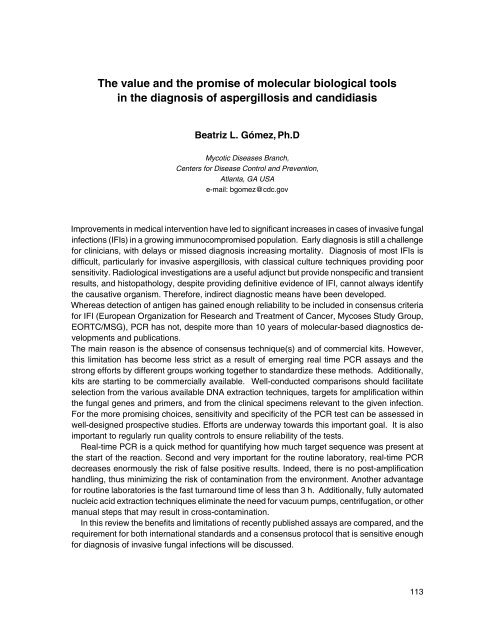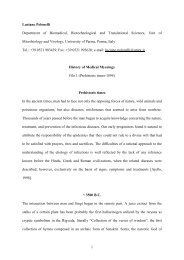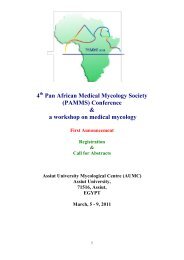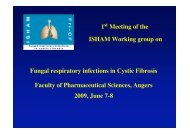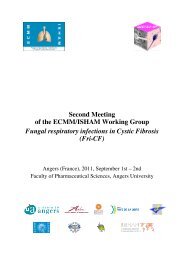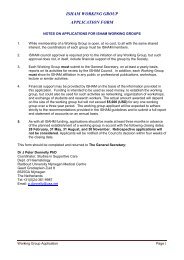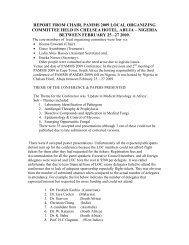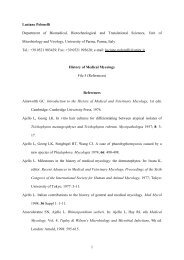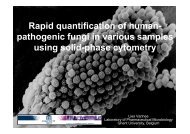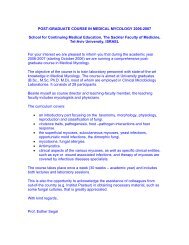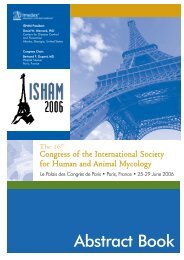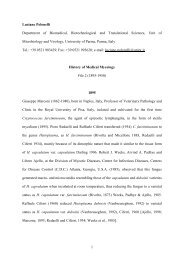Memoria CD.indd - ISHAM
Memoria CD.indd - ISHAM
Memoria CD.indd - ISHAM
You also want an ePaper? Increase the reach of your titles
YUMPU automatically turns print PDFs into web optimized ePapers that Google loves.
The value and the promise of molecular biological toolsin the diagnosis of aspergillosis and candidiasisBeatriz L. Gómez, Ph.DMycotic Diseases Branch,Centers for Disease Control and Prevention,Atlanta, GA USAe-mail: bgomez@cdc.govImprovements in medical intervention have led to significant increases in cases of invasive fungalinfections (IFIs) in a growing immunocompromised population. Early diagnosis is still a challengefor clinicians, with delays or missed diagnosis increasing mortality. Diagnosis of most IFIs isdifficult, particularly for invasive aspergillosis, with classical culture techniques providing poorsensitivity. Radiological investigations are a useful adjunct but provide nonspecific and transientresults, and histopathology, despite providing definitive evidence of IFI, cannot always identifythe causative organism. Therefore, indirect diagnostic means have been developed.Whereas detection of antigen has gained enough reliability to be included in consensus criteriafor IFI (European Organization for Research and Treatment of Cancer, Mycoses Study Group,EORTC/MSG), PCR has not, despite more than 10 years of molecular-based diagnostics developmentsand publications.The main reason is the absence of consensus technique(s) and of commercial kits. However,this limitation has become less strict as a result of emerging real time PCR assays and thestrong efforts by different groups working together to standardize these methods. Additionally,kits are starting to be commercially available. Well-conducted comparisons should facilitateselection from the various available DNA extraction techniques, targets for amplification withinthe fungal genes and primers, and from the clinical specimens relevant to the given infection.For the more promising choices, sensitivity and specificity of the PCR test can be assessed inwell-designed prospective studies. Efforts are underway towards this important goal. It is alsoimportant to regularly run quality controls to ensure reliability of the tests.Real-time PCR is a quick method for quantifying how much target sequence was present atthe start of the reaction. Second and very important for the routine laboratory, real-time PCRdecreases enormously the risk of false positive results. Indeed, there is no post-amplificationhandling, thus minimizing the risk of contamination from the environment. Another advantagefor routine laboratories is the fast turnaround time of less than 3 h. Additionally, fully automatednucleic acid extraction techniques eliminate the need for vacuum pumps, centrifugation, or othermanual steps that may result in cross-contamination.In this review the benefits and limitations of recently published assays are compared, and therequirement for both international standards and a consensus protocol that is sensitive enoughfor diagnosis of invasive fungal infections will be discussed.113


